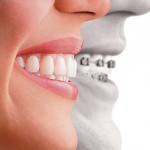Straighter Teeth: Invisalign vs. Different Kinds of Braces

In the past, those wishing to have straighter teeth had only one option: metal braces. While these have long been the only choice for someone who wanted to have straighter teeth, they came along with a number of complications that have made them not just a huge inconvenience, but actually dangerous to have in the mouth if not cared for correctly. For those to whom metal braces were just too inconvenient, the choice was usually to just go without straight teeth. These days, however, there are a myriad of other options, from ceramic braces, to lingual braces, to Invisalign, all of which have their positive and negative aspects. Keep reading to discover which option is right for you.
Traditional Braces
These braces sport the standard metal brackets and wires. In the past, these braces sported large, intrusive brackets to hold the wire in the mouth and secure it firmly to the teeth. However, in recent years, the brackets have become smaller and new technology has enabled this type of braces to become far more effective than they once were. Relatively low cost and fast-acting, traditional braces are still a viable choice for anyone who wants or needs straighter teeth.
Though they are less expensive than other kinds, they are still fairly noticeable, which can make them a negative for a self-conscious child, who may have to wear them for years to get the desired result. Though technology has improved, there are still some dangers that come along with these braces, especially if the patient does not stay on top of their oral hygiene. Cavities can become more common, and it is easy to eat the wrong kind of food and push the wire out of alignment, which can cause further discomfort in the mouth. Metal braces some along with a number of restrictions, which must be followed in order for the teeth to move appropriately and for the mouth to stay healthy why the braces are in place.
Ceramic Braces
Instead of metal brackets, ceramic braces boast teeth-colored brackets, which blend into the teeth and make the braces far less noticeable than other versions. They are still brackets, however, which means that the same restrictions that comes along with metal braces are in effect for ceramic braces. For most people, however, it is much easier to deal with ceramic brackets than with metal ones, simply because they are invisible on the teeth.
They also work much faster than the clean, plastic tray approach that Invisalign offers, though they will move the teeth at exactly the same rate as metal braces. In some circumstances, you may even be able to get a white wire installed in the brackets, so that they are almost entirely invisible.
Ceramic braces will be a little more expensive than their metal alternative, but many people are willing to pay the extra fee in order to not have a mouth full of metal. Though ceramic braces are not any easier to clean, because they are white, they are not as easy to see—that is the only real benefit. Patients should keep in mind that ceramic braces must be regularly and thoroughly cleaned or, like teeth, the brackets can become discolored and as unsightly as metal braces.
Lingual Braces
When it comes to braces, lingual braces are the only option that is completely invisible from without the mouth. Instead of putting the brackets on the outside surface of the teeth, the brackets are placed on the inside, in the same way and with the same wire structure, which will gradually move the teeth by gradually pulling and pushing them into alignment. However, instead of being completely visible on the surface of the teeth, the brackets are invisible, hidden by the teeth themselves.
These braces come along with the same restrictions as other braces, and because they are on the inside of the bite, they can be more difficult to clean and easier to break. It can also be more difficult to adapt to the adjustments and to the metal in your mouth, than with traditional braces. Things like adjustments take longer because they are more labor intensive for your orthodontist, and the braces themselves will be more expensive than the regular set. However, lingual braces are a great way to take advantage of metal braces, without advertising to the world that you are working towards straighter teeth, especially for those who would forgo straightening their teeth if it meant getting traditional braces.
Invisalign
Invisalign is the last option for teeth straightening and one of the newest available to patients. Invisalign works by providing the patient with a series of clear liners, not unlike the plastic retainers provided to those who have finished a traditional braces regimen, or like mouth guards that athletes wear. These aligner trays can be put in and removed—which for most patients, is a huge benefit. The patient puts in one aligner, lets it move the teeth to the correct position, and then switches to the next aligner. The ability to take it out, eat, brush teeth, and thoroughly clean the trays, are all giant advantages over a traditional braces system.
While Invisalign has a myriad of benefits, it also has some negatives. For example, the trays will not fix serious misalignments and it is more expensive than traditional braces. In some cases, treatment will also take longer than with other options, especially if the patient takes out the trays more often than he should. If the trays are lost (something that is impossible with braces), they are expensive to replace. For those who cannot or will not get metal or ceramic braces, however, Invisalign is a great way to fix minor problems and improve the bite.
Have more questions about Invisalign Treatments? Contact us for your complimentary consultation.


Leave a Reply
You must be logged in to post a comment.